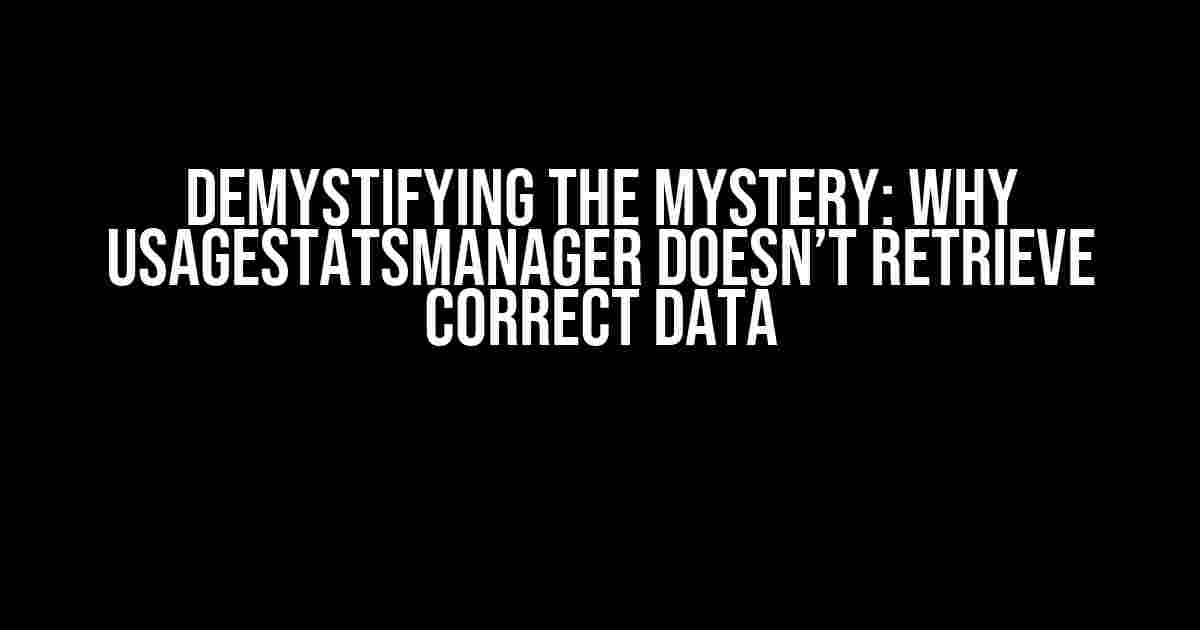As an Android developer, you’ve likely stumbled upon the UsageStatsManager API, which promises to provide valuable insights into your app’s usage patterns. However, you might have encountered a frustrating issue – the data retrieved by UsageStatsManager simply isn’t accurate. In this article, we’ll delve into the reasons behind this phenomenon and provide actionable solutions to get the correct data.
Understanding the UsageStatsManager API
The UsageStatsManager API, introduced in Android 5.0 (Lollipop), allows developers to access usage statistics for apps, including the total time spent in each app, the number of launches, and the last time the app was used. This data can be incredibly valuable for improving the user experience, identifying trends, and optimizing resource allocation.
// Get the UsageStatsManager instance
UsageStatsManager usm = (UsageStatsManager) context.getSystemService(Context.USAGE_STATS_SERVICE);
// Get the usage stats for the last 7 days
Calendar cal = Calendar.getInstance();
cal.add(Calendar.DAY_OF_YEAR, -7);
Long endTime = cal.getTimeInMillis();
cal.add(Calendar.DAY_OF_YEAR, -30);
Long startTime = cal.getTimeInMillis();
List<UsageStats> usageStatsList = usm.queryUsageStats(UsageStatsManager.INTERVAL_DAILY, startTime, endTime);
Common Reasons for Incorrect Data
Before we dive into the solutions, let’s explore the reasons why UsageStatsManager might not be retrieving correct data:
- Lack of Permission: Make sure your app has the
android.permission.PACKAGE_USAGE_STATSpermission declared in the AndroidManifest.xml file and that the user has granted the permission. - Insufficient Data: The UsageStatsManager API requires a minimum amount of data to generate accurate results. If your app has been installed for a short period or has limited usage, the data might be incomplete.
- Incorrect Time Range: Ensure that the time range specified in the
queryUsageStats()method is correct and covers the desired period. - Device Restrictions: Some devices or custom ROMs might have restrictions on accessing usage statistics, leading to inaccurate data.
Solutions to the Problem
To overcome the issue of incorrect data retrieval, follow these steps:
- Verify Permissions: Double-check that your app has the necessary permission and that the user has granted it.
- Wait for a Minimum Amount of Time: Allow your app to collect data for at least 24 hours before querying the UsageStatsManager API.
- Use a Larger Time Range: Increase the time range specified in the
queryUsageStats()method to ensure that you’re covering a sufficient period. - Check for Device Restrictions: Test your app on different devices and custom ROMs to identify any potential restrictions.
- Use Alternative Solutions: Consider using alternative APIs or libraries, such as the
AppUsageStatisticsAPI or third-party libraries likeandroid-anr-watchdog, which might provide more accurate data.
Example Code: Retrieving Correct Data with UsageStatsManager
private void queryUsageStats() {
UsageStatsManager usm = (UsageStatsManager) getSystemService(Context.USAGE_STATS_SERVICE);
// Set the time range to the last 7 days
Calendar cal = Calendar.getInstance();
cal.add(Calendar.DAY_OF_YEAR, -7);
Long endTime = cal.getTimeInMillis();
cal.add(Calendar.DAY_OF_YEAR, -30);
Long startTime = cal.getTimeInMillis();
// Query the usage stats
List<UsageStats> usageStatsList = usm.queryUsageStats(UsageStatsManager.INTERVAL_DAILY, startTime, endTime);
// Process the usage stats
for (UsageStats usageStats : usageStatsList) {
Log.d("UsageStats", "Package: " + usageStats.getPackageName() + ", Total Time: " + usageStats.getTotalTimeInForeground());
}
}
| API Method | Description |
|---|---|
queryUsageStats() |
Returns a list of UsageStats objects for the specified time range |
getTotalTimeInForeground() |
Returns the total time the app was in the foreground |
getLastTimeUsed() |
Returns the last time the app was used |
getInstanceCount() |
Returns the number of times the app was launched |
Conclusion
In this article, we’ve explored the reasons behind the UsageStatsManager API not retrieving correct data and provided actionable solutions to overcome this issue. By understanding the API’s limitations, verifying permissions, and using alternative solutions, you can unlock valuable insights into your app’s usage patterns. Remember to test your app thoroughly and adjust your approach as needed to ensure accurate data retrieval.
With the correct data in hand, you can:
- Optimize resource allocation and improve performance
- Enhance the user experience with personalized features
- Identify trends and patterns to inform future development
By mastering the UsageStatsManager API, you’ll be well on your way to creating a more efficient, user-friendly, and successful app.
Frequently Asked Question
Get to the bottom of the UsageStatsManager conundrum with our expert answers!
Why does UsageStatsManager not provide accurate data on app usage?
The UsageStatsManager may not provide accurate data if the device’s usage stats are not up-to-date. To get the most recent data, use the `queryUsageStats()` method with the `Interval.BUCKET_DAILY` interval and a `beginTime` set to a recent timestamp. Additionally, make sure your app has the necessary permissions and is running on a device with Android 5.0 (API level 21) or higher.
How often does Android update the usage stats, and can I force an update?
Android updates usage stats periodically, usually every few hours. You can’t force an immediate update, but you can use the `UsageStatsManager.updateUsageStats()` method to request an update. However, this method is only available on Android 10 (API level 29) and later.
What is the minimum TimeInterval for which I can query usage stats?
The minimum TimeInterval for which you can query usage stats is one day. You can use the `Interval.BUCKET_DAILY` interval to get daily usage stats. However, if you need more granular data, you can use a shorter TimeInterval, such as one hour, but be aware that this may affect performance.
Can I get usage stats for a specific app or package?
Yes, you can get usage stats for a specific app or package by using the `queryUsageStats()` method and specifying the package name in the `UsageStatsManager` instance. You can also use the `get AppStandbyBucket()` method to get the standby bucket for a specific app.
How do I handle errors and exceptions when using the UsageStatsManager?
When using the UsageStatsManager, you should always check for errors and exceptions, such as `SecurityException` or `NullPointerException`. Handle these exceptions by catching and logging the error, and then retrying the operation or providing a fallback solution. Additionally, make sure to check the Android API level and device compatibility before using the UsageStatsManager.




